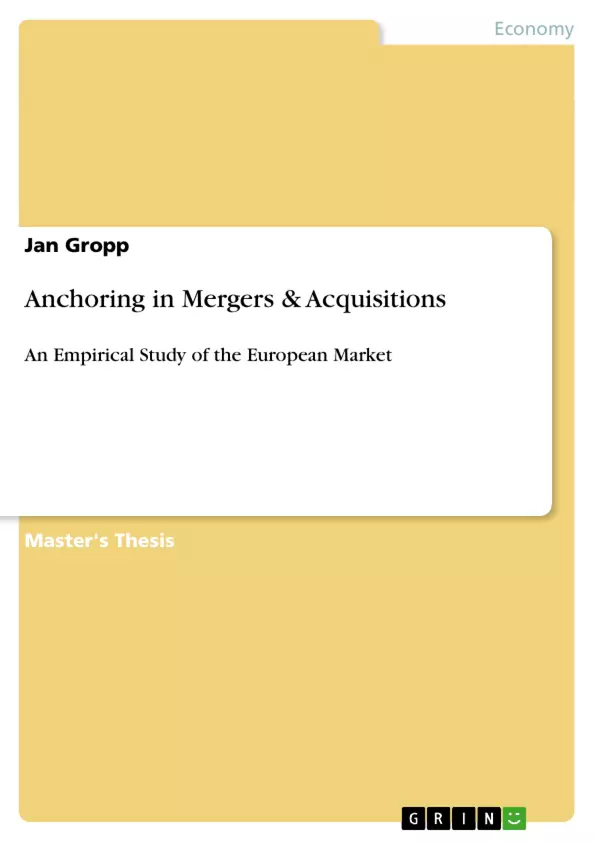Several studies show that people are often influenced by reference points which are derived
from the context at hand in estimations or decisions under uncertainty. This analysis deals with
the importance of reference points in the UK and to a lesser extent the European takeover
market. Applying "prospect theory" to equity investment we would predict that shareholders
value gains and losses relative to a reference point in a very human fashion. In a psychological
bias called the "anchoring effect", investors adopt irrelevant salient anchor values as reference
points and are biased towards these. We follow these predictions and, in this thesis, test
historic peak prices as anchor values in corporate takeovers for bidder and target management
as well as shareholders. Firstly, we analyze whether bid prices are affected by the 13-, 26-, 39-,
52- and 65-week high prices. Secondly, we are interested in whether for companies whose
valuation has fallen far from the historic peaks, these anchor values are of lesser relevance,
consistent with the S-shaped form of the prospect theory value function. Finally, bidding above
the historic peak prices is tested and analyzed, in whether this entails a higher probability of
bidding success.
For the purpose of the thesis, a dataset of in total 1602 takeover bids for listed companies in
the United Kingdom (1559), Germany (36) and Poland (7) from Thomson ONE Banker was
constructed. The sample includes bids announced and completed in the time period of 1985 -
2011. Data on stock price history for the target companies was extracted from Thomson
Reuters Datastream. OLS regression, Gaussian Kernel Regression, Piecewise Linear Regression
and Probit regressions are the tools employed to thoroughly analyze the data.
We find that all historic reference values examined exhibit statistically significant impact on the
bidder offer prices with diminishing impact of the reference prices observed for extreme
values. Importantly, no statistically significant evidence that bidding above historic peak prices
secures a higher acceptance rate from target shareholders was discovered. This finding does
not support the reference point thinking for target shareholders. The same is true for offer
price increases. Offer prices below peak prices do not carry a higher probability of being
amended than offer prices ranging above reference prices.
Inhaltsverzeichnis (Table of Contents)
- 1 Introduction
- 1.1 Objective and Contribution
- 1.2 Research Methodology
- 1.3 Main Findings
- 1.4 Limitations
- 1.5 Structure of the Study
- 2 Literature Review
- 2.1 Traditional Merger Theory
- 2.2 Behavioral Merger Theory
- 2.3 Reference Point Thinking
- 2.3.1 Theory
- 2.3.2 Anchoring in Economics and Finance
- 2.3.3 Anchoring in Mergers and Acquisitions
- 3 Hypotheses
- 4 Sample Composition and Methods
- 4.1 Dataset
- 4.2 Definition of Variables
- 4.3 Methods
- 4.3.1 Winsorization
- 4.3.2 Linear Regression
- 4.3.3 Gaussian Kernel Regression
- 4.3.4 Piecewise Linear Regression
- 4.3.5 Probit Regression
- 4.4 Descriptive Statistics
- 5 Results and Findings
- 5.1 Reference Pricing in Takeover Bids
- 5.1.1 Linear Analysis
- 5.1.2 Non-linear Effects
- 5.1.3 Robustness Checks
- 5.2 Takeover Success and the Adjustment of Takeover Pricing
- 5.2.1 Reference Prices and Deal Success
- 5.2.2 Reference Prices and Offer Adjustment
- 5.2.3 Robustness Checks
- 5.3 Discussion of Findings
- 5.4 Limitation of Results
- 5.1 Reference Pricing in Takeover Bids
- 6 Summary and Perspectives
Zielsetzung und Themenschwerpunkte (Objectives and Key Themes)
This research explores the impact of reference points on bidder and target behavior in mergers and acquisitions (M&A) within the European market, primarily focusing on the UK. The study aims to analyze whether historic peak prices serve as anchor values influencing bid prices and takeover success rates.- Reference point theory in M&A
- Anchoring effect in financial decision-making
- Impact of historic peak prices on bid prices
- Relationship between reference points and takeover success
- Application of behavioral finance principles to M&A
Zusammenfassung der Kapitel (Chapter Summaries)
- Chapter 1 provides an introduction to the research, outlining the objective, research methodology, main findings, limitations, and structure of the study.
- Chapter 2 reviews existing literature on traditional and behavioral merger theory, with a particular focus on reference point thinking and its application to economics and finance, including M&A.
- Chapter 3 presents the hypotheses formulated based on the literature review, exploring the impact of reference points on bid prices and takeover success.
- Chapter 4 details the dataset used in the study, defining key variables and outlining the methodological approach, including various regression techniques and descriptive statistics.
- Chapter 5 presents the results of the analysis, examining the influence of reference prices on takeover bids, exploring both linear and non-linear effects, and assessing the relationship between reference points and deal success. Robustness checks are also conducted to ensure the reliability of the findings.
Schlüsselwörter (Keywords)
This research examines the application of reference point theory and the anchoring effect in mergers and acquisitions. It analyzes the influence of historic peak prices on bid prices and takeover success in the UK and European market, utilizing various regression techniques and a comprehensive dataset of takeover bids. Key concepts explored include behavioral finance, M&A decision-making, bid price determination, takeover success, and empirical analysis.- Arbeit zitieren
- Jan Gropp (Autor:in), 2012, Anchoring in Mergers & Acquisitions, München, GRIN Verlag, https://www.grin.com/document/204433



